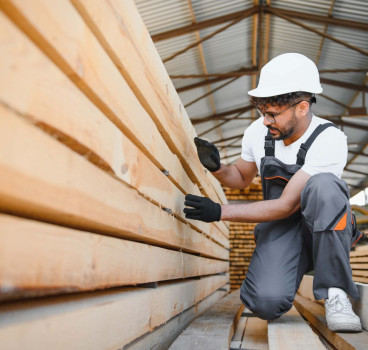The top five sustainable building materials- or are they?
When you talk about construction and the built environment – everyone wants to mention sustainability. Maybe it has something to do with the fact that the construction industry has a significant environmental footprint. However, this is changing – with a growing focus on sustainability which is driving innovation in building materials, with eco-friendly options emerging for every project phase writes John Ridgeway.
Ask a panel of experts about the most effective and sustainable building materials, the ones that should be used on every single project, then you will almost get a mixed reaction, but we at Talk.Build reckon we have five leading contenders – so let’s open up the debate.
Number one – recycled aggregates
In the number one position for us are recycled aggregates - crushed and processed construction and demolition (C&D) waste materials like concrete, asphalt, and brick. Traditional aggregate extraction can have a significant environmental impact, including deforestation, habitat destruction, and air pollution. Recycled aggregates offer a more sustainable alternative, reducing reliance on virgin resources and diverting waste from landfills – so what’s not to like.
Recycling reduces the need for quarrying and its associated environmental damage, meaning less reliance on virgin materials like gravel and crushed rock. It is frequently less expensive than virgin aggregates due to readily available local sources – and in certain conditions recycled aggregates can sometimes outperform virgin materials in specific applications.
Road base and subbase are common applications for recycled aggregates, providing a strong foundation for roads and pavements. They can also be used as a partial replacement for virgin aggregates in concrete production and are particularly suitable for walkways, driveways, and decorative applications in gardens and parks.
Number two - FSC-Certified wood
Number two on our list is FSC-certified wood. Forest Stewardship Council (FSC) certification ensures wood comes from responsibly managed forests that meet environmental, social, and economic standards.
Deforestation is a major environmental concern which is why FSC-certified wood promotes sustainable forest practices, protecting biodiversity and ensuring long-term forest health.
This promotes responsible management of forests, minimising environmental damage, protects wildlife habitats within forest, encourages the use of wood from sustainable sources and ensures fair treatment of forest workers and local communities.
FSC-certified wood can be used for framing, trusses, and other structural elements and are ideal for flooring, panelling, and cabinetry. FSC-certified wood also ensures responsible sourcing for doors and windows.
Number three - Engineered Bamboo
At number three is engineered bamboo, a rapidly renewable resource processed from fast-growing moso bamboo. It offers a strong, versatile, and eco-friendly alternative to traditional wood products as it grows quickly, requires minimal land compared to trees and has a high carbon sequestration capacity.
Engineered bamboo offers excellent strength-to-weight ratio, making it suitable for a wide range of applications. As it is naturally resistant to moisture and insects, it requires minimal maintenance and its unique appearance adds warmth and a touch of nature to interior spaces.
Engineered bamboo offers a durable and sustainable alternative to hardwood flooring, creates a visually stunning and eco-friendly accent wall and is strong and lightweight.
Number four - recycled content insulation:
Recycled content insulation uses materials such as recycled plastic bottles, cellulose (recycled paper) and glass fibres to provide thermal insulation. Energy efficiency is crucial for sustainable buildings and recycled content insulation offers excellent thermal performance while diverting waste from landfills and reducing reliance on virgin materials.
It particularly diverts plastic bottles, paper, and glass from landfills, provides excellent thermal performance, reducing heating and cooling costs and can be a cost-competitive alternative to some traditional insulation materials.
Blown-in cellulose or batt insulation made with recycled content can be used in wall cavities. Loose-fill or batt insulation made with recycled materials also provides superior thermal performance in attics. Rigid board insulation with recycled content is now widely used to help insulate crawl spaces.
Number five - low-VOC paints and coatings
Low-volatile organic compound (VOC) paints and coatings minimise the emission of harmful chemicals that can negatively impact indoor air quality. This is a major concern as many traditional paints and coatings can release harmful VOCs that contribute to health problems. Low-VOC alternatives offer a healthier choice.
Low-VOC paints often utilise recycled content and bio-based ingredients and many low-VOC paints offer excellent durability and performance comparable to traditional paints.
Building a sustainable future
These five sustainable building materials represent just a fraction of the eco-friendly options available. By incorporating these and other sustainable materials throughout the construction process, we can build structures that are not only functional and beautiful but will also kind to the environment. By making informed choices, construction professionals can play a vital role in creating a more sustainable future for our built environment.
We do not necessarily expect your all to agree with our choice – but we are always open to suggestions. Let us know what you think.
Additional Blogs

What if Building Control went fully digital?
Building control governs structural integrity, fire protection, energy efficiency, accessibility and countless other aspects of design and construction. Historically, this process has been highly...
Read moreWhere most “Smart Buildings” go wrong
Smart buildings are often presented as the ultimate in modern construction - interconnected, efficient, intuitive and driven by real-time data. They promise lower operating costs, reduced energy use,...
Read more

The future of facilities management starts at RIBA Stage 0
Facilities management has traditionally been treated as a discipline that only becomes relevant once a building is handed over. At that point, FM professionals inherit decisions made months or years...
Read more